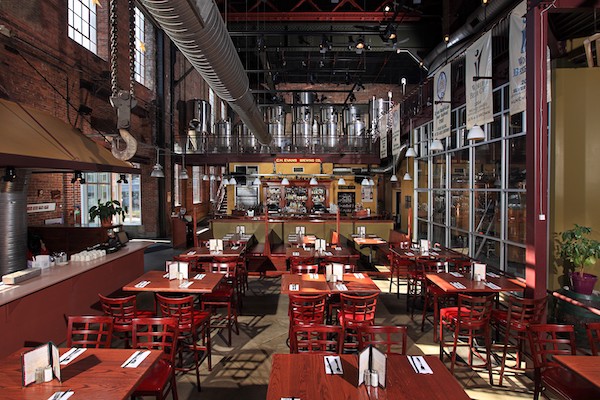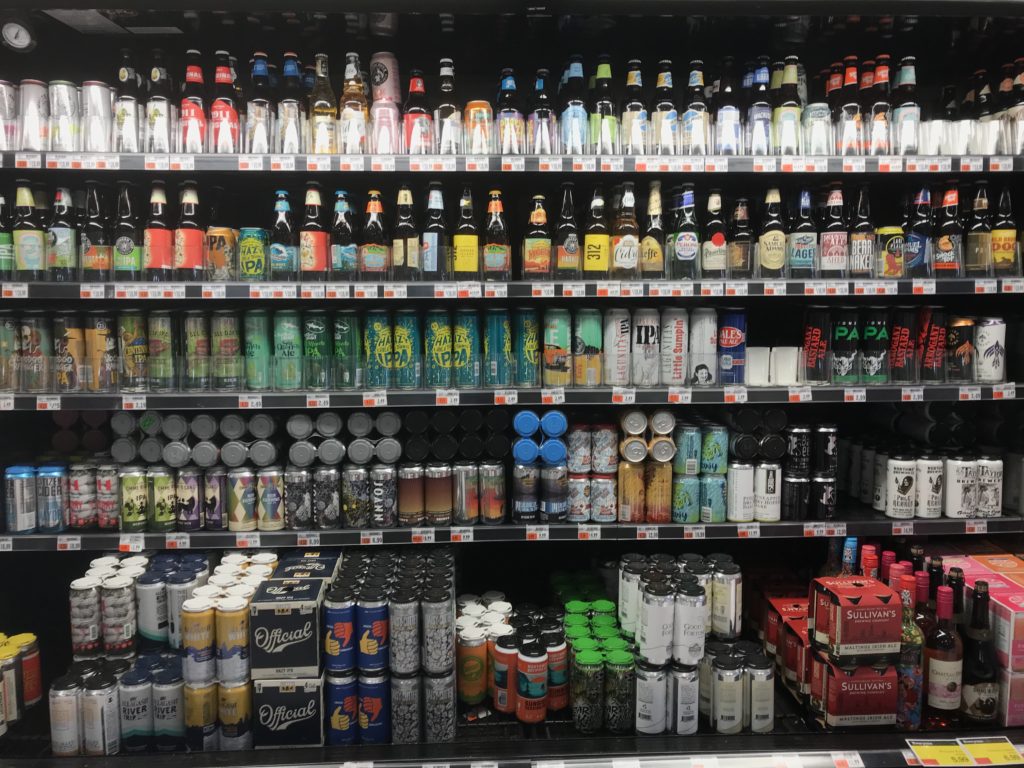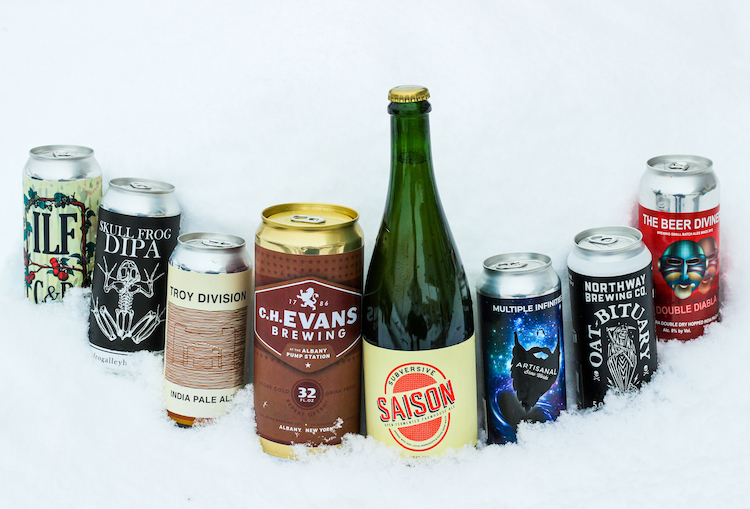We’re not trying to go all Economics 101 on you, but as an industry grows, certain companies begin to stand out as owning the largest market share until only a few control almost the entire industry. The process is called consolidation, and it’s very much how the beer industry has worked throughout the years. In 2009, the top five companies, including big dogs Anheuser-Busch InBev and MillerCoors, controlled a combined 88 percent of the beer market. But then something incredible happened. Over the next decade, instead of increasing their shares of the market, those beer-hemoths actually lost market share, dropping to a combined 79 percent of the market in 2019. A nearly 10 percent drop in just 10 years is nothing short of seismic. Its cause? The craft beer revolution.
Since 2005, the number of breweries in the US has exploded from just under 1,500 to well over 8,000, despite total US beer consumption dropping. In New York State alone, the brewery count more than quadrupled from 95 to 415 between 2012-18, with dozens of breweries popping up in the Capital Region. While not all of the 8,386 breweries in the country are technically “craft breweries”—the Coors and Budweiser breweries are included in that number—the vast majority are. But what exactly is craft beer? Where did it come from? How did it disrupt a tried-and-true rule of economics? And, most importantly, where does the Capital Region fit in? Let’s find out.
The definition of craft beer is nebulous, but two of my personal favorite stabs at it come from California brewers in the film Craft: The California Beer Documentary. One: “If you can meet the guy that made it, it’s craft.” The other: “If the beer tastes good, it’s probably craft.” (California is widely credited as the birthplace of the modern craft beer revolution.) Kevin Mullen, owner and head brewer at Troy’s Rare Form Brewery and secretary of the New York State Brewers Association board of directors, on the other hand, defines craft beer as a process. “I think what happens with a lot of breweries is they’ll make one beer, and they’re happy with it, and then they just kind of leave that recipe alone and walk away from it,” he says. “To me, that’s not craft.” What makes it into craft beer, Kevin says, is when a customer comes in a month or year down the line, tries that same beer, and it’s noticeably different. “You’ll be like, ‘Wow, this tastes even better,’ because slowly we’re making changes to make it a better beer over time.”
The Brewers Association (BA) doesn’t even have an official definition for craft beer, but it does define a craft brewer as one that is small (annual production of six million barrels of beer or less) and independent (less than 25 percent of the brewery is owned by an entity that is not a brewer). For the record, that’s a pretty broad definition; it’s widely assumed the BA upped the barrel maximum to accommodate Boston Beer Company, which produces Samuel Adams, arguably the country’s most popular craft beer. Boston Beer produces 5.3 million barrels of beer per year. To put that into perspective, New York’s F.X. Matt Brewing Company, which brews the Saranac line of beers, produces about 350,000 barrels per year, while Cooperstown’s Brewery Ommegang produces just 35,000.
No matter what your definition is of craft beer, you can’t deny that there’s been a craze that has swept across the nation in recent years. But if you’re looking at craft beer in New York’s Capital Region, specifically, you have to go back in time much farther back than the craft beer boom of the late 2000s and the craft “boomlet” of the 1980s. (Way) back in the day, even before Prohibition, Albany was nothing short of a craft beer superpower.
Eleven years ago, beer bloggers Craig Gravina and Alan McLeod came across an early 19th-century advertisement for something called Albany Ale. Realizing there was little information out there about it, the duo launched the Albany Ale Project, a research endeavor to find out anything and everything about the seemingly forgotten brew. In 2014, they published their findings about the region’s rich brewing history in the book Upper Hudson Valley Beer. “What Albany Ale was all over the country, initially, was sort of the best beer being brewed in the greater Upper Hudson Valley—Poughkeepsie to about Troy,” Gravina says. “It was pretty strong stuff: anywhere between nine and 13 percent alcohol. Because of the early Dutch establishing Albany as a brewing center through the 18th and into the 19th century, you had this influx of brewers from Scotland. They started coming to Albany, Troy, Hudson and Poughkeepsie, and the industry grew from there to the point where, by the mid-1850s, Albany Ale was pretty much all over the country. We’ve seen it as far away as Hawaii, we’ve seen advertisements for it in Suriname.”
One key to Albany’s brewing success was its location at the nexus of the Hudson River and Erie Canal. Raw materials were shipped east to the state capital on the canal, where the beer was produced and then sent south on the Hudson to New York City, from which it could be shipped anywhere in the world. Hops also grew wild in upstate, making it easy for Albany brewers to get their hands on one of the four main ingredients of beer. By the mid-19th century, the City of Albany was producing the second-most beer in the world, second only to London.
With the advent of railroads and the new demand for lighter lagers, Albany’s monopoly on beer production and distribution waned, and Albany Ale disappeared completely during the Prohibition Era. But thanks to the investigative work of Gravina and McLeod, Albany will forever be remembered as a beer city. “Whether it’s the first Dutch [settlers] that arrived here, the Erie Canal, Prohibition, consolidation or union issues, the story of our area can be told through beer,” Gravina says. “And because there was so much beer being made here, it, in turn, affected the history itself.”
Of course, Albany Ale wasn’t the Capital Region beer industry’s only casualty of Prohibition. In the 1920s, after trying its hand at producing nonalcoholic beer, Hudson brewery CH Evans, which had operated in the Friendly City since 1786, was sold and raided for violation of Prohibition laws before it fell victim to a massive fire that burned the 12-building facility to the ground in 1930. (Ironically, the Evans family had built the City of Hudson’s firehouse.)
When Prohibition was finally repealed in 1933, neither the national nor the local beer industry bounced right back. The number of breweries in the US grew to 857 in 1941 before declining slowly for the next four decades until there was just 89 total, in the entire country, in 1978. But, as luck would have it, it was about that time that something big began brewing right here in the Capital Region.

In 1980, Bill Newman took what he had learned as a brewer’s apprentice in London and opened Wm. S. Newman Brewing Company in an old mattress warehouse on Broadway in Albany, making him one of the first (if not the first) craft brewer on the East Coast (Gravina says that some speculate NYC’s New Amsterdam Brewery was up and running before Newman’s). Regardless, Newman is considered the “godfather” of craft brewing, having mentored Jim Patterson of Abita Brewing in New Orleans and Jim Koch, cofounder of Boston Beer Co. “Either I’m a fool or I’m a hero, but I’m confident I’ll be brewing beer till I’m 80,” Newman told the Albany Times Union in 1983. “I believe small brewers are entering a renaissance period in America.” Newman was onto something: small brewers were about to have a major comeback.
The same year Newman opened his brewery in Albany, a young CH “Neil” Evans IV (whose same-named great-grandfather presided over the aforementioned CH Evans during the Prohibition Era) was just catching the brewing bug. Already a passionate home brewer, the Hudson native had ventured out to Lake Tahoe, CA, for a three-week ski trip and ended up staying there for 15 years. While out west, he heard about a small brewery called Sierra Nevada that had just opened and decided to make the three-and-a-half-hour drive to Chico to check it out. This, of course, was before the days of MapQuest or GPS, so when he got close, Evans stopped at a gas station to ask for directions. “The girl at the counter said, ‘I get off in 15 minutes. I’ll go with you,’” Evans says. Needless to say, drinking ensued, and Evans was hooked.
When Evans returned to the Capital Region, he decided he wanted to open a brewery of his own. “I had another business at the time and I worked really, really hard for 10 years to put money away, so that this could happen,” he says. In the mid-’90s, Evans purchased the old Albany Pump Station, a water system facility that serviced the Capital City from 1895-1932 but had since fallen into disrepair. “The construction project took two-and-a-half years,” Evans says. “Because I didn’t have any background in construction, it was not easy. I couldn’t afford to hire a contractor to do it. We finally got it open and we were successful right out of the gate.” That was in 1999. CH Evans Brewing Company (the second one) became one of only a handful of breweries in the Capital Region, including Albany’s Big House Brewing Co., which closed in the mid-2000s, and Troy’s Brown’s Brewing Company, which opened in 1993—the same year Newman ended up closing his pioneering brewery—and remains open to this day.
“Back in 1999, I think I had visited every brewery that was open in New York State,” Evans says. “Do you know how many breweries there are in New York State now? Over 420. Back then, we all knew each other, and now we don’t.” But that doesn’t mean there isn’t still a camaraderie that exists between brewers. “One of the things I think is great is everywhere you go, the community of brewers is all kind of the same—very welcoming, very resourceful,” says Rare Form’s Mullen. (It’s common for brewers to share tips, equipment and even personnel.) Locally, Bloodville Brewery brews out of Northway Brewing Co.’s Queensbury facility, and Mullen has actually stepped in as CH Evans’ brewmaster.
That communal aspect extends beyond those directly involved in the production of craft beer to those who sell it. Pint Sized, a small bar and bottle shop with locations in Albany and Saratoga Springs, is the perfect example. “Having a chill vibe is the most important thing to me,” says owner August Rosa. “I want people to feel like they’re at their friend’s apartment. I don’t want anyone being turned off by some sort of bougie vibe that they don’t feel like they can connect with. That could be a reason why craft beer has blown up so huge: Because it’s super accessible and has a very welcoming environment.”
That “chill vibe” theory surely holds some weight—for many, a brewery’s atmosphere is equally as important as its beer selection—but it’s hardly enough to explain the craft beer explosion. To do that, we need to dig a little deeper.

The rise and fall of craft beer’s popularity has a lot to do with politics, too. After Prohibition, a three-tier system was implemented in the beer industry. “Basically, a brewer is supposed to brew beer, sell it to a distributor, and then, that distributor, sometimes called a wholesaler, sells it to a retail account,” says Nate Reynolds, a Malta-based market sales manager for Sierra Nevada, the same brewery that Evans visited back on the West Coast in its first year in business. “Then, that retail account sells it to a consumer,” Reynolds continues. “It makes for fair margins and makes sure everybody’s getting a piece.” But when President Ronald Reagan relaxed antitrust laws in the early ’80s, it allowed for increased consolidation—big brewers could get closer and closer to monopolizing the industry. (Granted, a few years earlier, Congress had legalized home brewing, which accounted for the craft boomlet in the early 1980s.) Then, more that two decades later, legislation in New York permitted Empire State brewers to conduct tastings and serve beer by the glass, undeniably boosting craft beer’s popularity within New York.
Policy changes can only do so much though. The craft beer boom was also made possible because consumers developed a taste for—wait for it—craft beer. (Remember: if it tastes good, it’s probably craft.) “It used to be that craft beer was against the world,” Reynolds says. “People were like, ‘No, I just like my light beer and I don’t want to try an oatmeal stout—no thanks. What’s happened in the last 10 years is it’s been flipped on its head, where even someone like my father, who has traditionally just stuck to Yuengling, is now calling me excited about this IPA that he just found.” (Yuengling isn’t the best example—its parent company, D.G. Yuengling and Son, has been classified a craft brewer since 2014. But you get Reynolds’ point.)

That exploration of new craft brews is a major factor in the beverage’s popularity, too. “People are looking for what’s new,” Pint Sized’s Rosa says. “That’s the question I get all the time: ‘What’s new?’ We’re always excited about what new, inventive kind of brew is out there.” It used to be that beer had pretty much one flavor—beer. Sure, one with more hops would be more bitter, and one with more malt would be sweeter, but the general flavors were pretty much unchanging. Now, in Glens Falls alone, you can get a peanut butter and fluff porter (Mean Max Brew Works), a cranberry pomegranate sour (Common Roots Brewing) and an ale that tastes like a blueberry dessert (Coopers Cave Ale Company), all in one afternoon.
But perhaps the biggest reason craft has exploded is because of a trend that extends far beyond the boundaries of grain, hops, yeast and water: buying local. Just as there has been a movement by American shoppers away from big box retailers and toward small businesses, so, too, has there been a movement by American beer drinkers away from big brewers like Budweiser and toward locally owned craft brewers and microbreweries (which the BA defines as breweries that produce less than 15,000 barrels of beer per year and sell 75 percent or more of their beer off-site).
Even within the industry itself, local has taken the spotlight, especially in New York. In 2012, New York Governor Andrew Cuomo passed the farm brewing law, which aimed to increase demand for locally grown products and incentivized brewers to use New York–produced ingredients. Now, in order for a New York brewery to receive a farm brewery license, which affords it certain privileges regular microbreweries don’t have, its beers must be made with at least 60 percent New York–grown ingredients. “A New York IPA would be a full-New-York-ingredients IPA, which is great,” Mullen says. “We have some good producers and malters and hop growers, and that can actually happen, whereas a few years ago it wouldn’t [have been possible].” It’s true: Before Gov. Cuomo passed the farm brewery law, there were no malt houses in the state. Now, there are more than a dozen, including Subversive Malting + Brewing in Catskill.
Despite all the momentum and new breweries mushrooming up, it’s reasonable to wonder whether craft beer is just another fad. Can the US economy truly sustain more than 8,000 breweries, or will the craft beer bubble eventually burst? “They’ve been talking about the bubble bursting for years,” Mullen says. “But there’s still a lot of these small communities out there that don’t have breweries. And for every small town that doesn’t have a brewery, there can still be a brewery that can succeed.” Guilderland Center, for instance, will get its first taste of a hyper-local beer when new brewery Mixed Breed Brewing opens this spring.
Reynolds sees things a bit differently. Before joining Sierra Nevada, he worked as a craft brand manager for Mechanicville-based DeCrescente Distribution Co., where he began to see a decrease in the number of craft brands it carried. “Distributors are scaling back their warehouses right now,” he says. “When their warehouses can’t get any bigger and there’s constant innovation, these distributors are like, ‘Well, I’ve got to look at every slot in my warehouse as what’s paying the rent and just focus on that.’” What is paying the rent? Craft beers that have really good brand marketing. Bars don’t just want any old IPA anymore, they want that specific IPA from Unified Beerworks, or that specific IPA from Frog Alley Brewing. And hard seltzer, too. “Seltzer is printing money.” Indeed: Hard seltzer sales grew 226.4 percent in 2019, and are expected to grow to a $6.5 billion business by 2024, per a Jefferies Financial Group analysis. One of hard seltzer’s largest producers? Truly, which is owned by none other than craft beer titan Boston Beer Co.
Reynolds, of course, is looking at things from a distributor’s standpoint, the second tier of beer’s sacred three-tier system. But thanks to the Craft New York Act, which allows brewers to sell directly to consumers, that three-tier system has partially eroded, at least in the Empire State. “All of a sudden these little guys don’t have to rely on a distributor anymore,” Reynolds says. “It’s now cool to go to breweries. My bachelor party started up in Schroon Lake at Paradox and worked its way all the way down to Brown’s Brewing in Troy and hit every single brewery on the way. I think it’s OK that distributors aren’t going to be pushing [beers from smaller brewers]. You’re just not going to see them in supermarkets.” (But you may see them on your doorstep: Alcohol delivery apps such as Drizly are now stepping in as pseudo-distributors, effectively removing third-tier retailers from the beer-selling process.)
Despite these differing opinions, there has been a documented slowdown in the production of craft beer over the last few years. While production is still on the upswing, 2019 saw it grow at its slowest pace since 2003. And then, of course, there’s the elephant in the taproom: the pandemic. “Every brewery out there is hurting,” Mullen says. “Smaller breweries like us [base our business] on people either coming into the taproom or kegs going to bars. Well, kegs to bars is gone.” A brewery’s saving grace is canning, which Mullen’s brewery does do. Sure, you can pick up a four-pack of Rare Form brews to-go at its Troy taproom. Or you can now get one at Trader Joe’s in Colonie or Whole Foods in Albany, thanks to distribution deals Mullen inked because of COVID. The larger the canning and distribution operation, the smaller the impact the pandemic has had on business.
But many local breweries don’t can their beer. While most offer growlers or crowlers (32-ounce cans that can be filled and sealed one by one), they make the majority of their money in on-premises consumption. CH Evans is one example, and, to make a bad situation worse, the majority of the brewpub’s business comes from people who work in Albany, or are in town for a concert or show. It doesn’t take a brewmaster to figure out that, during COVID, CH Evans’ customer base pretty much doesn’t exist anymore. I was there at 4pm this past New Year’s Eve, chatting with Evans at the bar, and the brewpub was completely empty. “We’ve been here 21 years,” he says. “Up until the last year we were OK. And now we’re not. So can we survive? I hope so.”
Craft beer is hardly the only industry that the pandemic has taken a toll on. And like every other locally owned business in the service industry, craft breweries are only going to survive if the communities they’re located in come out to support them. In New York, craft beer still makes up less than 20 percent of the total beer market. That means more than 80 percent of beer sales could be directed towards local brewers. So, if you’re one of those people who thinks craft beer is just dark, heavy and not for you, think again. “There are so many different styles of beer and stories behind them,” Mullen says. “People get caught up with ‘what is the hype beer?’ or ‘what should I be trying?’ You can find a beer for anybody in the craft world. Even if they don’t like beer, there’s something out there that they will like.”
Luckily, many Upstate New Yorkers are already hooked on craft beer. “I’ve never had a customer be like, ‘Oh, yeah, I’m just not into craft beer anymore, I’m back to Bud Light,’” Rosa says. “I’ve never had that happen before, and I don’t foresee it happening.” Craft beer, it seems, is here to stay.





